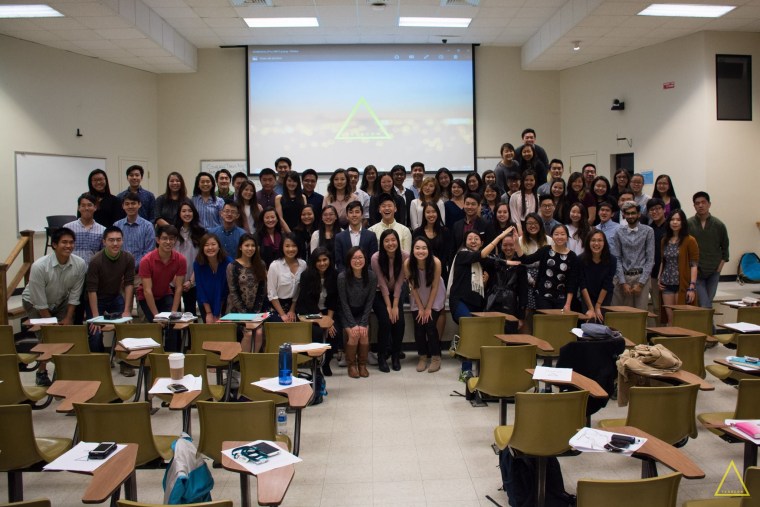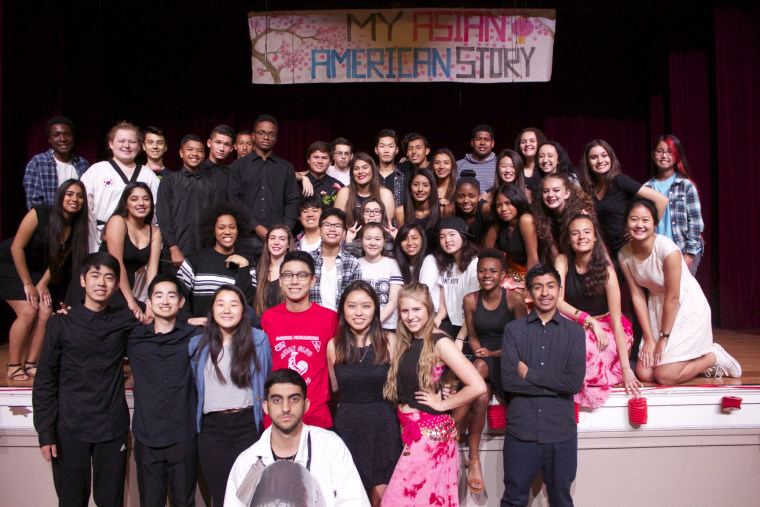Last August, just a few days before the first day of school, I was following the presidential election. I had finally heard someone talk about Asians — unfortunately, it was in the context of Asians having “anchor babies.” In search for a response, I went on Twitter and asked a few congressional representatives for a comment. Not receiving any, I asked Jenn Fang of Reappropriate for her feedback and support about starting a hashtag via Twitter, and minutes later, #MyAsianAmericanStory was born.
At first, I envisioned the tag as a way to specifically counter the “anchor baby” narrative and I thought that people would share their immigration stories, but users took it to another level by sharing other aspects their lives as members of the AAPI community. They shared stories about being asked where they were “REALLY” from and about being told that they spoke “really GOOD English.”
And they used the tag in more effective and poignant ways than I could ever have imagined. People shared history, sorrows, dreams, rants, jokes, old photos — and made our community come alive. We challenged the dominant narrative that we were invisible or apathetic. We told the world in no uncertain terms that no one but us would tell our stories.
Over night, the hashtag went viral. But how did this happen? Perhaps it was timing or luck, but part of it was because it was so easy to be part of #MyAsianAmericanStory. The tag was easy to remember and general enough to be versatile. There were no directions to follow. It was YOUR tag and your expression. In addition, since this was all online, there were few physical, economic, or social boundaries. It didn’t matter if you lived in Omaha or Oakland. It didn’t matter if you were a fifth-generation Filipino American or a just-got-here-last-Tuesday American. You did not have to be part of an organization or a university.
There were few obstacles to entry, and speaking for myself, I know that’s why I gravitated toward Twitter. In many ways, social media was my only entry into AAPI politics. I have no affiliations with any activist organizations, and I don’t have a background in Asian American Studies or even a college degree. I’m like most AAPIs: we want to get involved, but don’t see many open doors other than social media.
SHARE YOUR STORY: Submit your #MyAsianAmericanStory here
Some of you who might surprised that there are “barriers” to entering the conversation about AAPIs, but this is a sentiment that I have heard repeatedly from students and others who would like to participate but aren’t sure how. Recently, I attended the Triangle-Area Asian American Students Conference — where the conference's theme, along with the theme of a recent assembly held at the Marshall Fundamental Secondary School in Pasadena, California, was #MyAsianAmericanStory — and met students from the University of North Carolina - Chapel Hill, North Carolina State University, and Duke University. I asked a few students what they felt was most useful about the tag, and most responded like John Park, who noted that the “tag provided a sense of community and avenue for communication for a group of people whose stories and opinions are often either not heard or not even spoken about. It reduced the barrier to entry in regards to talking about being AAPI and allowed people to see that they aren’t alone in the issues and struggles they face.”
Thus, the tag has taught me that we are still at a point that many young AAPIs don’t even feel that they have a platform from which to voice their opinions. And on that point, I’d like to ask members of the AAPI activist establishment what they think they can do in order provide more welcoming platforms for our community’s voices.
I think social media and hashtags are effective ways to do this but I know that "hashtag activism" and social media in general have poor reputations among some members of the AAPI activist community. And let’s be fair: no one, not even me, thinks that a tag all by itself will bring change. But lots of older and well-credentialed folks have let me know in no uncertain terms that a “tag is nothing but a tag” — small in scope, a blip in time, and “just” social media rather than “real” social change.

I get it. It’s no Asian American Studies tome, and no, I haven’t been arrested at any sit-ins or occupations (yet). I understand that I’m not doing things like you did, and I recognize that we wouldn’t be where we are today without your work and work of countless others. I know that, right now, I’m just a kid with a phone. I hear you. But if one of the goals is to strengthen our community by expanding the scope of our messages, why shouldn’t we use social media if it helps us reach more of our community? Why wouldn’t AAPI activists use social media to break out of the echo chamber to reach the rest of us?
I don’t think the popularity of #MyAsianAmericanStory was a fluke. I think it is an indication that our community is very comfortable with and adept at using social media, but perhaps activists aren’t leveraging social media often enough. Maybe there is a lingering sense of wariness after the #CancelColbert fiasco or perhaps some feel that tags are somehow too “corporate,” but if you want to see how tags and social media can mobilize folks, just take a look at the thousands of Chinese and Chinese Americans who showed up to support NYPD Officer Peter Liang. That was a masterful example of how social media (in this case, WeChat) was used to craft a narrative and provide an impetus for a real life response. You might not agree with Liang's supporters, but it’s hard not to see that social media can be a powerful tool for mobilizing people outside the traditional core of activists.
Recently, there have been more hashtag campaigns that have made powerful strides for our community in terms of increasing visibility. The Smithsonian Asian Pacific American Center started a campaign in late 2015 called #BeLikeDarsh in response to a racist meme that included a photo of the first Sikh American to play NCAA basketball, Darsh Singh. The #BeLikeDarsh tag successfully highlighted an important figure in our community, and also positively spotlighted the Sikh Americans at a time when presidential candidates and others were heightening their anti-immigrant and anti-Muslim rhetoric, thereby providing a clear and challenging counter-narrative to the mainstream discussion.
This tag was followed by the campaign #MySikhAmericanLife started by The Sikh Coalition which featured photos and stories of Sikh Americans and their everyday lives in the U.S. in a further effort to humanize the Sikh American experience.
These tags were easy to use, understand, and personalize, and they provided platforms for Sikh Americans to voice their concerns and share their stories with each others and those outside of the community. To me, these are important first steps to fostering a culture of speaking out and activism among the larger community, and for that reason, I continue to think that tags are an important tool to extend the scope of activism. If you have never been involved before, you might not want to join a protest, but you might be okay with simply using a tag. After using a few hashtags and seeing others use the tag, perhaps you might become more comfortable with sharing your views and reaching out to others, and perhaps then you might feel more invested and aware … and maybe even vote.
This Asian Pacific American Heritage Month, you can also help increase AAPI visibility by speaking out and sharing even more of your views to #MyAsianAmericanStory. Let our community be your strength. Working on a project? Rely on us to give it a signal boost. Tell us when you are mad because we might be mad right along with you. Rely on us to applaud your victories and provide a soft place to fall. Our community is inclusive and generous: these are people who paid attention to some random 15 year old. They will listen to you.
Here’s to our community, your continued participation, and to an Asian Pacific Heritage Month so awesome that it flows into summer.
Help us continue the conversation and submit your #MyAsianAmericanStory content to our Tumblr page! We will be posting your submissions (read the full guidelines here).
Jason Fong is a third generation Chinese-Korean American born and raised in Los Angeles. He is the creator of #MyAsianAmericanStory, and is currently a student at Redondo Beach Union High School in California.
Follow NBC Asian America on Facebook, Twitter, Instagram, and Tumblr.
